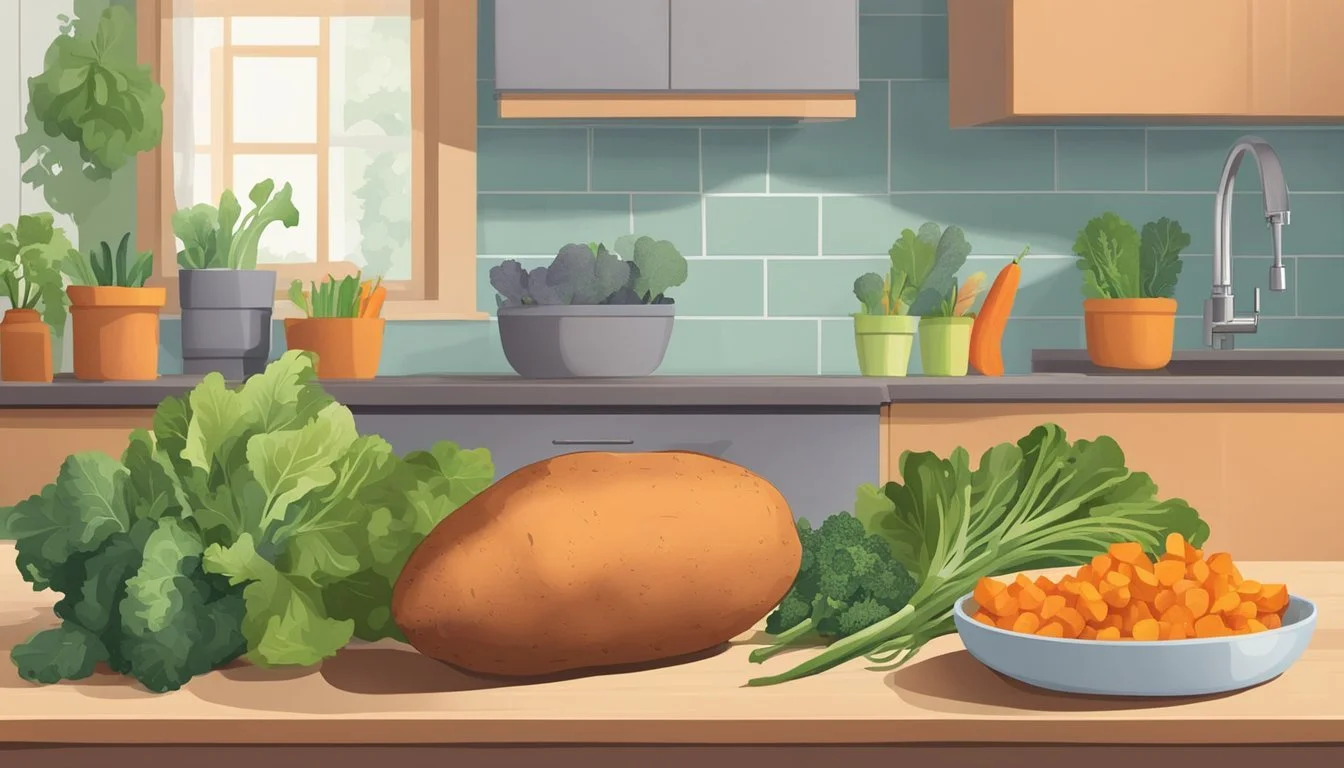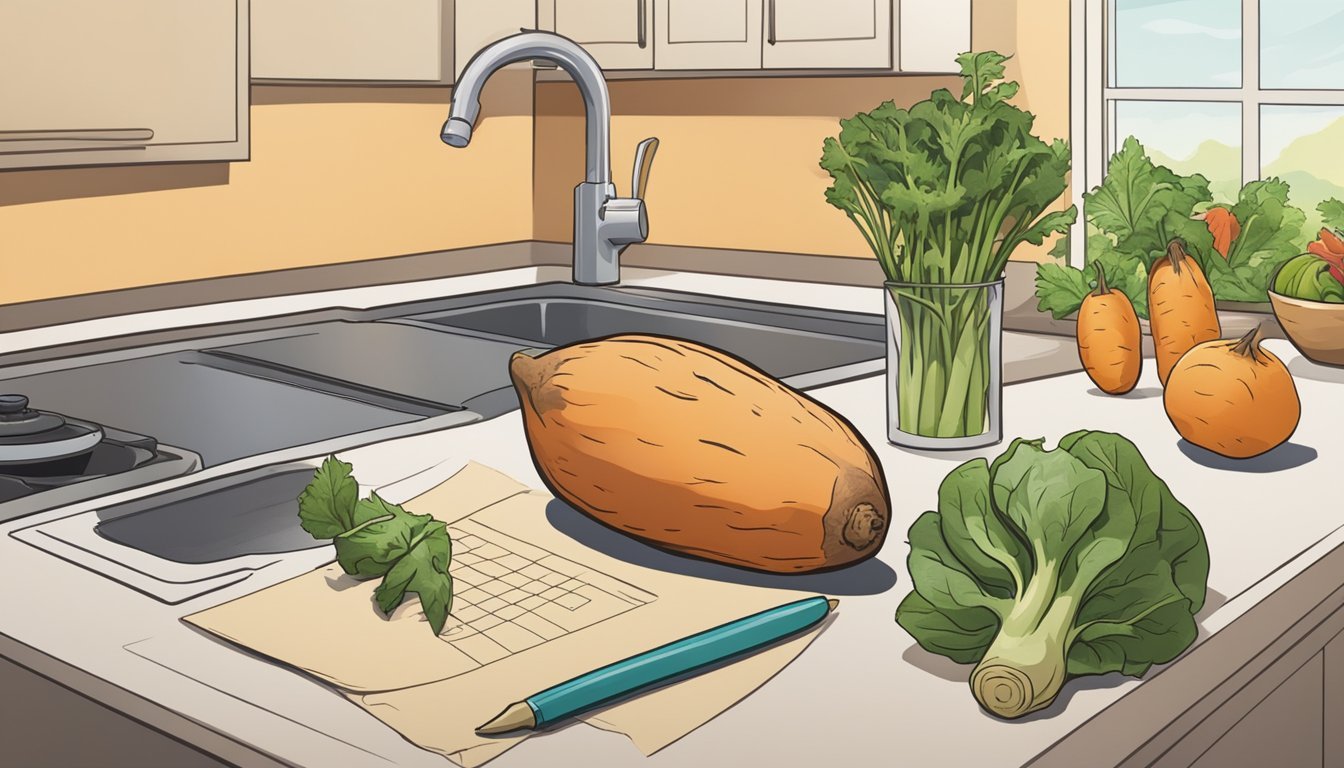How Long Do Sweet Potatoes Last?
Shelf Life and Storage Tips
Sweet potatoes (What wine goes well with potatoes?) are cherished for their delicious flavor, nutritional value, and versatility in various cuisines. Understanding their shelf life is crucial for maintaining their taste and health benefits. Typically, when stored in a cool, dark, and dry place, reminiscent of a traditional root cellar, sweet potatoes (What wine goes well with sweet potatoes?) can remain fresh for approximately one month. This optimal storage environment prevents premature spoilage and maintains the sweet potatoes' quality.
It is, however, common practice to keep raw sweet potatoes at room temperature, like on a kitchen counter. In such conditions, they usually last for up to two weeks. To extend the shelf life and preserve their texture and flavor, ensuring proper air circulation is key. This can be achieved by storing the sweet potatoes in a loosely covered bag or an open-weave basket, which allows air to move freely around them.
For those wishing to keep sweet potatoes for an extended period, freezing offers a viable solution. Sweet potatoes can be frozen, either cooked or raw, with cooked ones typically lasting longer when frozen. When placed in a freezer bag or an airtight container, sweet potatoes maintain their quality for up to 12 months in the freezer. This method provides a practical means of having sweet potatoes available throughout the year, ready for use in various dishes.
Sweet Potato Basics
Sweet potatoes are a nutrient-dense root vegetable commonly used in various cuisines worldwide. They offer significant dietary benefits and come in different varieties.
Identifying Sweet Potatoes
Sweet potatoes are distinguished by their elongated shape and smooth skin, which ranges in color from yellow, orange, red, brown to purple. Flesh colors can also vary from white to orange and even purple. They are often confused with yams, but true yams are a different species entirely.
Nutritional Value
Sweet potatoes are an excellent source of fiber, vitamins, and minerals. They are particularly high in vitamin A, with a single medium sweet potato providing over 100% of the daily recommended intake. Sweet potatoes also contain a good dose of vitamin C, vitamins B5 and B6, potassium, and manganese. The vegetable comes packed with iron and provides a moderate amount of sugar, contributing to its naturally sweet flavor. Here's a quick rundown of the nutritional content:
Fiber: Essential for digestive health.
Vitamins: A variety of B-vitamins and a high vitamin A content.
Minerals: Supplies key minerals like iron and potassium.
Sugar: Contains natural sugars that enhance its sweet taste.
This combination makes sweet potatoes a healthful addition to any diet, providing energy and supporting overall health.
Storing Sweet Potatoes
Proper storage of sweet potatoes is essential to maintain freshness and flavor. Specific conditions like temperature and humidity greatly influence their shelf life.
Ideal Storage Conditions
Storing sweet potatoes properly necessitates a cool, dark, and dry location. They thrive in temperatures around 55°F (13°C). High humidity levels are favorable, but direct contact with moisture should be avoided to prevent rot. Ventilation is key, as it keeps the air around the sweet potatoes circulating, reducing the risk of spoilage.
Pantry Storage
In a pantry, sweet potatoes can last up to two weeks when left on the counter. For a slightly longer shelf life up to a month, a well-ventilated basket or an open-weave basket in a cool, dark section of the pantry is ideal. Ensure the area is free from heat sources and not prone to drastic temperature changes.
Refrigerator Storage
Storing sweet potatoes in the refrigerator is generally not recommended, as temperatures below 55°F can convert the vegetable's starches into sugars, affecting their taste and texture. If refrigerated, use them as soon as possible.
Freezer Storage
To extend their shelf life, sweet potatoes can be stored in the freezer. It is recommended to cook them first by boiling or baking. Once cooled, they can be mashed or sliced and then sealed in freezer-safe airtight containers or resealable bags. They can be kept frozen for approximately 10 to 12 months, maintaining quality and flavor.
Shelf Life of Sweet Potatoes
The shelf life of sweet potatoes varies depending on whether they are whole, cut, or cooked. Proper storage is crucial to maintaining their freshness and nutritional value.
Whole Sweet Potatoes
Whole sweet potatoes have a considerable storage lifespan. In the pantry, they can last between 3-5 weeks when stored in a cool, dark place. Refrigeration can extend their shelf life up to 2-3 months. The key is to keep them in a dry area that is shielded from sunlight.
Pantry: 3-5 weeks
Refrigerator: 2-3 months
Cut Sweet Potatoes
Once sweet potatoes are cut, their shelf life decreases. Cut sweet potatoes should be refrigerated and used relatively quickly, as they will last only about 24 hours in the pantry and a few days in the refrigerator. To extend their freshness, they should be immersed in water and stored in an airtight container.
Pantry (within a water-filled container): 24 hours
Refrigerator: 3-5 days
Cooked Sweet Potatoes
Cooked sweet potatoes, when stored properly in a refrigerator, can last for 3 to 5 days. It is vital that they cool to room temperature before refrigeration to prevent condensation and bacterial growth, but they should not be left out for more than 2 hours to avoid the risk of foodborne illness.
Refrigerator: 3-5 days
Room Temperature: Discard after 2 hours
Signs of Spoilage
Recognizing the signs of spoilage in sweet potatoes is crucial for food safety. They exhibit clear signs of degradation, ranging from visual cues to textural changes and odors.
Visual Indicators
Sweet potatoes begin to show visual changes when they start to spoil:
Discoloration: They should have a uniform color. Dark spots or black areas are often indicators of rot.
Sprouting: While small sprouts can be removed, extensive sprouting suggests the sweet potato is past its prime.
Mold: Presence of mold, which can appear in various colors such as white, green, or black, is a sure sign the sweet potato should not be consumed.
Texture Changes
Texture is a good indicator of a sweet potato's condition:
Softening: Sweet potatoes should be firm. If they begin to soften or become mushy, they are deteriorating.
Mushiness: This could indicate the onset of rot, especially if it's localized to one area of the sweet potato.
Odor Detection
Finally, the smell of a sweet potato can signal spoilage:
Odor: A healthy sweet potato should not emit a noticeable smell. An off or foul odor is a red flag that the sweet potato has gone bad.
Extending Shelf Life
Proper storage techniques and preservation methods can significantly extend the shelf life of sweet potatoes. These approaches can help maintain the quality and edibility of sweet potatoes for an extended time.
Tips for Longer Storage
For optimal storage, sweet potatoes should be kept in a cool, dry, and dark place, preferably at a temperature range between 45°F to 55°F. Maintaining a consistent temperature helps prevent the sweet potatoes from spoiling prematurely. It is also crucial to ensure that they have adequate air circulation, which reduces the risk of moisture buildup and mold growth. One should avoid storing sweet potatoes in the refrigerator, as the cold temperature can affect their taste and texture. Instead, they can be stored in a pantry or cellar where the conditions are more suitable. Proper curing of sweet potatoes can also extend their shelf life. Curing involves keeping the newly harvested sweet potatoes in a warm place (approximately 80°F to 85°F) with high humidity (around 85% to 90%) for about 10 days. This process allows the skins to heal and a protective layer to form, reducing the chance of spoilage.
Using Preservation Methods
Freezing: Sweet potatoes can be frozen to prolong their shelf life. To freeze sweet potatoes, one should first cook them fully, as cooked sweet potatoes tend to last longer in the freezer. Once cooked, sweet potatoes can be stored in freezer bags or airtight containers. When properly stored, frozen sweet potatoes can last for up to 12 months.
Cooked: 12 months in the freezer
Uncooked: Not recommended
Lemon Juice: When preparing sweet potatoes for storage, applying lemon juice can help prevent discoloration. The lemon juice acts as an antioxidant, inhibiting the enzymatic browning that can occur when the flesh is exposed to air.
By adhering to these storage tips and preservation methods, one can ensure that sweet potatoes maintain their taste and nutritional value for as long as possible.
Preparing Sweet Potatoes
Before cooking sweet potatoes, proper preparation is essential to ensure they are clean and ready for your recipe. Whether making a sweet potato casserole, fries, or pie, starting with well-prepared potatoes will contribute to the dish's success.
Washing and Peeling
Sweet potatoes should be thoroughly washed before peeling to remove any dirt and grime. One can use a scrub brush to effectively clean the surface. Peeling is then typically done with a peeler or small knife, ensuring the removal of the skin is uniform and minimal flesh is wasted. Peeling is not always necessary, especially for rustic dishes where the skin adds texture and nutrients.
Cutting and Cooking
Once washed and peeled, cutting the sweet potatoes into uniform pieces is crucial for even cooking. Whether boiling or baking, consistent sizes contribute to uniformity in texture.
Boiling: Place the cut sweet potatoes in a pot of boiling water and cook until tender, which is a common preparation for mashing.
Baking: One can bake them whole or in slices at a consistent temperature until tender inside.
For sweet potato fries, lengthwise cuts are ideal. To achieve the perfect texture, they can be baked or fried. For dishes like sweet potato casserole or pie, mashed boiled sweet potatoes form the base and should be devoid of lumps for a smooth filling or topping.
Understanding Spoilage
Spoilage in sweet potatoes can occur due to various factors and recognizing the signs of edibility is crucial to consuming them safely.
Factors That Influence Decay
One must consider several elements that can accelerate the spoilage process of sweet potatoes:
Moisture: Excess moisture can promote the growth of mold and bacteria. Sweet potatoes should be kept in a dry environment to slow decay.
Heat: Warmer temperatures can cause sweet potatoes to sprout and decay quicker. It is advised to store them in a cool place.
Air Circulation: Adequate air circulation helps prevent moisture accumulation and mold formation. Storage in open-weave baskets or loosely covered bags is recommended.
Recognizing Edibility
When assessing the edibility of sweet potatoes, one should look for:
Texture: They should be firm to the touch; soft spots can signal spoilage.
Taste: A sour taste may indicate that the sweet potato has gone bad.
Appearance: Signs of spoilage include mold, dark spots, and an overall appearance of shriveling or wrinkling.
Smell: A musty or off odor is a clear indication that a sweet potato should not be consumed.
Creative Uses for Sweet Potatoes
Sweet potatoes offer a wealth of possibilities in the kitchen, from traditional dishes to innovative takes on leftovers. Their versatility shines through in a variety of recipes and the potential for transforming leftovers into entirely new meals.
Recipes and Dishes
Sweet Potato Casserole: This classic dish combines the natural sweetness of the potatoes with spices, nuts, and marshmallows, creating a beloved side dish especially popular during holiday meals (What wine goes well with holiday meals?).
Ingredients:
Sweet potatoes
Butter
Brown sugar
Pecans
Marshmallows
Spices (e.g., cinnamon, nutmeg)
Sweet Potato Fries: A healthier alternative to traditional fries, they can be baked or fried and seasoned with an array of spices.
Seasoning options:
Salt
Pepper
Paprika
Garlic powder
Sweet Potato Pie: An exquisite dessert, this pie balances the natural flavors of sweet potatoes with ingredients like vanilla and nutmeg, complete with a flaky crust.
Crust Options:
Traditional pie crust
Graham cracker crust
Baked Sweet Potatoes: Simply baked in their skins until tender, they can be topped with various ingredients, from a pat of butter to a sprinkle of cinnamon, or even stuffed with savory options like chili or pulled pork.
Mashed Sweet Potatoes: They provide a creamy and flavorful alternative to regular mashed potatoes and can be enhanced with milk, butter, and spices.
Leftovers Ideas
Sweet Potato Pancakes: Leftover mashed sweet potatoes can be mixed with flour, egg, and milk to form pancakes, offering a delightful breakfast option.
Add-ins:
Cinnamon
Chopped nuts
Maple syrup
Sweet Potato Hash: Sauté diced leftover roasted or baked sweet potatoes with onions, peppers, and spices for a hearty breakfast hash.
Protein Additions:
Bacon
Sausage
Eggs
Transforming leftovers into creative dishes not only maximizes the usage of sweet potatoes but also introduces new flavors and textures to the table. Whether in the form of a sweet dessert or a savory meal, sweet potatoes can be a key ingredient in a multitude of appealing and nutritious dishes.
Preventing Waste
Reducing waste starts with proper storage techniques and effective revival methods, ensuring sweet potatoes remain firm and flavorful for as long as possible. They prioritize maintaining the right temperature and detecting the best time to consume sweet potatoes at their ripest.
Storing Cooked Sweet Potatoes
Cooked sweet potatoes should be stored in the refrigerator to extend their shelf life. To preserve their quality:
Cool them to room temperature before refrigerating to prevent condensation and spoiling.
Use an airtight container to keep them from absorbing odors and to minimize exposure to moisture.
Consume within 5-7 days for best quality.
Reviving Soft Sweet Potatoes
When sweet potatoes start to get soft, they are not necessarily spoiled. Here's how to deal with them:
Cut away any spoiled or soft spots, which may be an initial sign of decay.
Cook immediately if they're just beginning to soften but still have a firm consistency.
Use for recipes that don’t rely on a firm texture, like soups or casseroles (What wine goes well with casseroles?).






